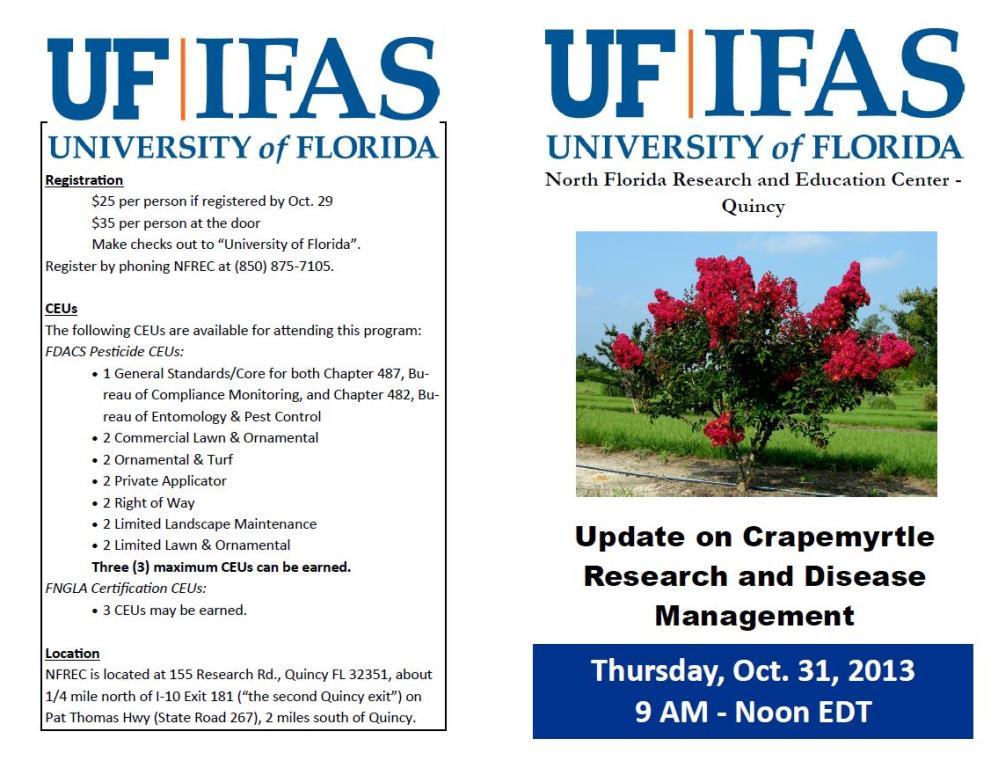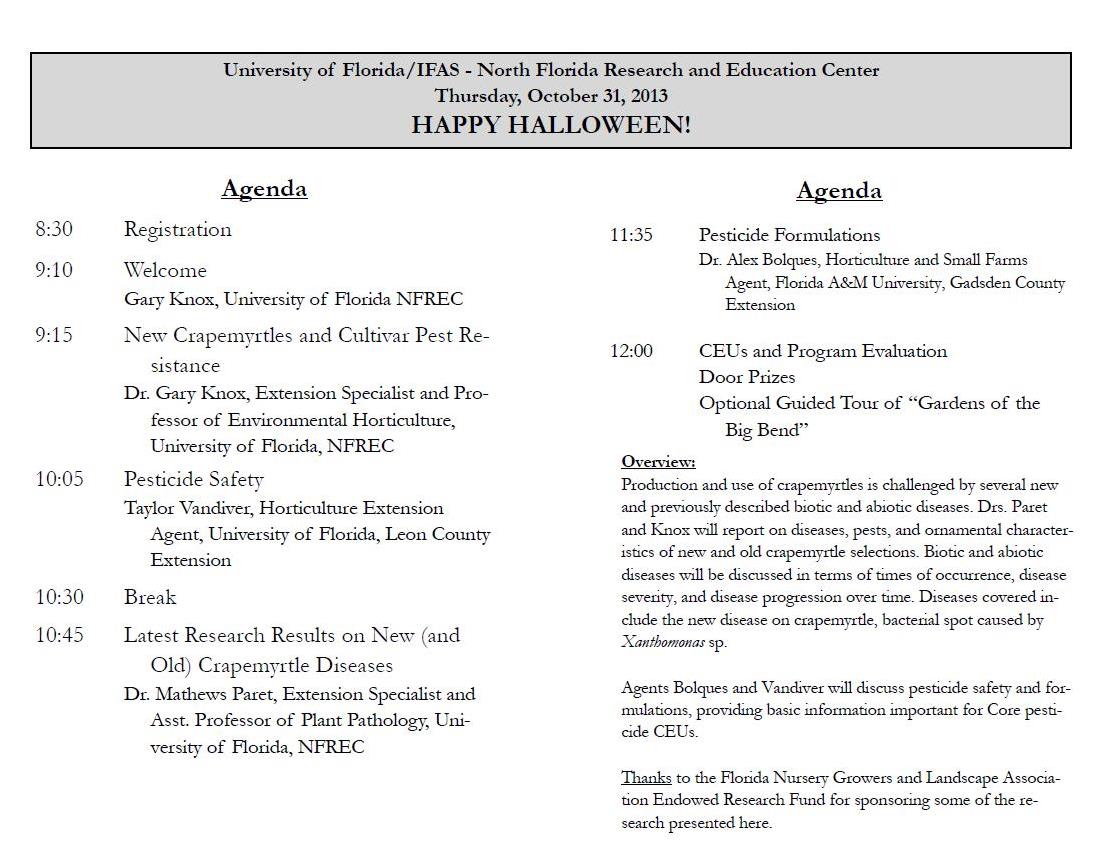by Taylor Vandiver | Oct 25, 2013
Caution…Worms at Work!
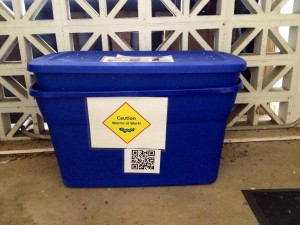
Vermicomposting bin at the Leon County Extension Office.
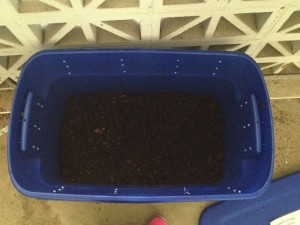
It’s difficult to see, but our worms are hard at work composting leftovers!
Many home gardeners may have thought about composting, but may not have the time, the space or, let’s face it, the patience. Well then vermicomposting is ideal to satisfy those conditions! Vermicomposting is the process of using worms and micro-organisms to turn food waste into a nutrient-rich compost called worm castings. Worm composting bins can take up less space than traditional composting bins and can even be kept inside.
Bins can be purchased or made at home, for those who want to compost on a budget. If the home gardener is planning on making their own there are a few things that should be considered. Make sure that the container won’t absorb too much water (such as cardboard), because worms need to stay moist. The container should also be made of a non-clear material. A good example would be 1-18 gallon plastic (not clear) container or a Styrofoam container with a lid. Holes need to be drilled about 4 inches from the top of the bin. Covering the air holes with a type of screen is a good idea to prevent the escape of the composters.
After the bin has been constructed bedding (shredded newspaper, etc.) will need to be placed at the bottom. The bedding should be moistened and then potting soil added on top of that. This will provide a good living habitat for your worms. The Number of worms that need to be added will depend on the container size. When getting worms, make sure to use red wigglers (Eisenia fetida) or African Nightcrawlers (Eudrilus eugeniae). Unlike earthworms found in the garden, these worms thrive in composting bin conditions. They can usually be found at bait stores or local worm farms.
Now its time to put them to work! Worms can be fed daily or weekly. One pound of worms can be fed about half a pound of kitchen scraps per day. When adding scraps avoid using animals products like eggs, cheese or meat. The ideal meal should include small scraps of vegetables, fruits, coffee grounds, bread and paper. When adding the scraps be sure to bury them under the soil. Store the worm bin in an area that does not receive direct sunlight and stays at a constant temperature of about 60 to 80 degrees. Be sure to have a lid for your container, this will keep light out and will also help prevent the appearance of flies. One pound of worms can turn 65 pounds of garbage into garden compost in about 110 days. Compost should be harvestable in a matter of months!
Vermicomposting is a great way to compost for those living in an apartment or those that have kitchen scraps as a main source of compost materials. Worm castings are used just like normal compost. Add them to plants and gardens as a soil amendment, use them in potting soil, or make a compost tea.
For more information contact your local UF/IFAS Extension Office.
by Matthew Orwat | Oct 23, 2013
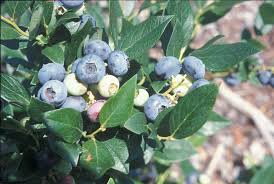
Image Credit: UF IFAS EDIS
From Dr. John P. Hayes”
“Florida Crossroads made a 28 minute video entitled “Seeds of Change” featuring the IFAS breeding efforts to create new varieties of blueberries, strawberries, tomatoes, and other crops, and the ways that these programs have influenced Florida industry.
For those of you who are familiar with our breeding programs, you’ll enjoy seeing some of our scientists on the screen. For those who aren’t familiar with IFAS development of new varieties, it is well worth the watch and I’d encourage you to do so. Our breeding program and the scientists engaged in breeding at UF are world class.”
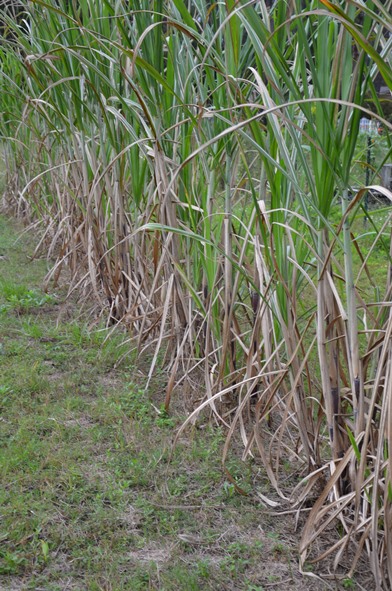
by Les Harrison | Oct 21, 2013

Row of sugar cane. Image Credit: Les Harrison
By Les Harrison, UF/IFAS Wakulla County Extension Director
October has ushered in the fall gardening season. Turnips, mustard, radishes, carrots and a variety of other cool season crops have emerged and are growing.
Another once common crop ready to be planted in October is sugar cane. Cane for processing is harvested, and select stalks with the most desirable traits are planted in October and November.
Planting is accomplished by digging a shallow furrow and laying the canes end-to-end. The cane is then covered with the soil removed from the furrows. Sugar cane may also be planted in north Florida during March.
In the days before mass market sweeteners, almost every farm had a patch of sugar cane. Some varieties were planted for processing into cane syrup, molasses and raw sugar, and some for chewing by the young and those with a sweet tooth.
When not pulling a plow or wagon, mules spent their days walking in a circle to drive a cane mill. Enterprising growers frequently sold their excess production as a means of generating another revenue stream to support the family farm.
Roadside sales of homemade cane syrup were a common sight in the rural south for many years. Sampling was a quality assurance courtesy offered to the potential buyer confirming the syrup had not been scorched while cooking.
The sugar cane plant is a form of grass with high sucrose content. It originated in south Asia where it has been cultivated for several millennia.
Over the centuries, sugar cane production followed the trade routes west. Christopher Columbus brought it to the New World on his second voyage west.
South Florida has long had a large commercial cane sugar industry with thousands of acres committed to growing and processing the sweetener on the outskirts of the Everglades. Louisiana is the other big sugar cane state, but Brazil is the global production champion.
The perennial nature of sugar cane allows growers to harvest the cane, and then grow the following years’ crop off the existing roots. Ratooning, as it is termed, is a widely used practice which has application for growing in panhandle Florida.
From a nutritional standpoint, sugar cane based products are a source of carbohydrates in the diet. Generally speaking, the reason for addition of sugar to a recipe is an issue of taste and flavor.
The sugar cane currently growing in the UF/IFAS Wakulla County demonstration garden was planted in November 2012. Tours of the garden are available during normal business hours.
To learn more about growing sugar cane in Wakulla County, visit the UF/IFAS Wakulla County website or call 850-926-3931 . And “Like” us on Facebook.
. And “Like” us on Facebook.
by Eddie Powell | Oct 21, 2013
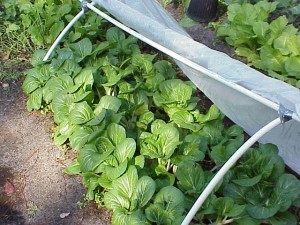
Image Credit: Eddie Powell
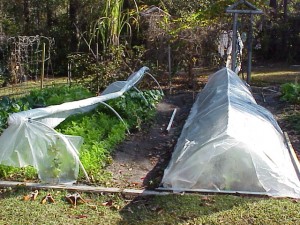
Image Credit: Eddie Powell
Every fall gardening season, Florida homeowners enjoy growing their own vegetables but are faced with cold weather issues. As early as November 1, a chance of frost is possible in Northwest Florida.
Most Cole Crops can be planted until November, but they must be protected from the cold weather or they will need to be replaced. A good variety of hardy plants should be planted in order to prevent total devastation of the garden by extremely cold weather. If tender plants are used, the following considerations must be observed.
Site selection for tender plants is the number one factor to be considered when preparing for a freeze. Vegetable plants need a site with good air drainage, and somewhat high in elevation relative to the area; not in a low area where cold air settles. Arranging tender plants along a barrier to protect them from cold winds improves the plants cold protection, especially from very hard freezes. Another factor to consider is that poorly drained soils result in weak shallow roots which are more susceptible to cold injury.
Plants grown with the correctly applied rate of nutrients will tolerate colder temperatures better and recover from cold injury faster than plants grown with little to no nutrients. Watering vegetable garden plants before a freeze can help protect plants. A well-watered soil will absorb more solar radiation than dry soil and will re-radiate heat during the night. This can improve hardiness by as much as 2°F. However, saturated soil conditions can damage the root systems of most plants over a few days, so make sure the ground is well-drained.
Healthy vegetable plants are more resistant to cold than vegetable plants weakened by disease, insect damage, or nematode damage. Routine inspection for pests and implementation of necessary control measures are essential. Feel free to contact your local county extension office for information on pest identification and recommended controls.
Plastic or cloth coverings can help protect vegetable plants more from frost than from extreme cold. Covers that extend to the ground and are not in contact with the vegetable plants’ foliage may reduce cold injury to the plant. If the vegetable plant foliage is in contact with the cover it is often cold burned or injured because of heat transfer from the foliage to the colder cover. Some examples of excellent plant covers are cloth sheets, quilts, commercial row cover such as “remay”, or black plastic. If plastic covering is used, it is extremely important to remove the covering during the day to provide ventilation of trapped heat. Failure to do so will result in certain death to the vegetables. To learn more on cold protection of vegetable plants please visit this EDIS article on frost protection.




